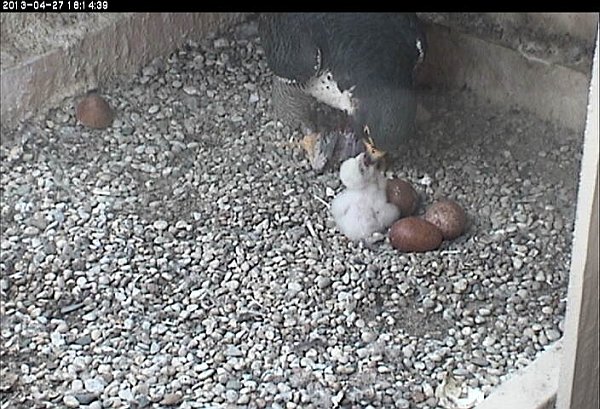
When you watch a feeding at the Cathedral of Learning peregrine nest you’ll see just one baby now.
As early as Friday morning, only 12 hours after he hatched, I could tell something was wrong with Chick#2. He was noticeably weaker and his movements were odd and uncoordinated. He seemed to have a developmental problem that caused spasms.
The big clue was that he left the nest. This is abnormal and life-threatening behavior in a chick so young. Peregrine nestlings must be brooded by their parents during their first week of life because they can’t thermoregulate yet.
On Friday afternoon Chick#2 literally rolled in a ball out from under Dorothy’s tail.
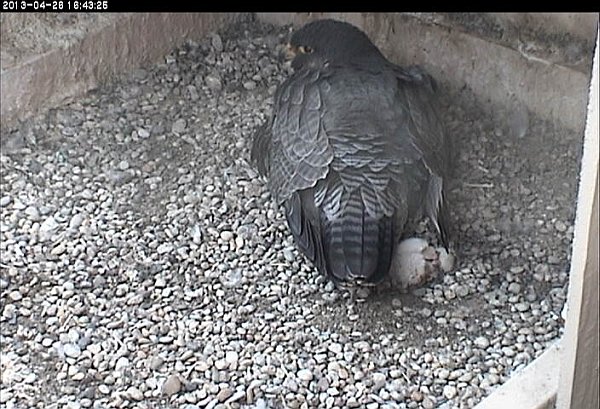
And here he moved outside Dorothy’s wing in 41 degree weather on Saturday morning. He must be twitching a lot considering the look on her face.
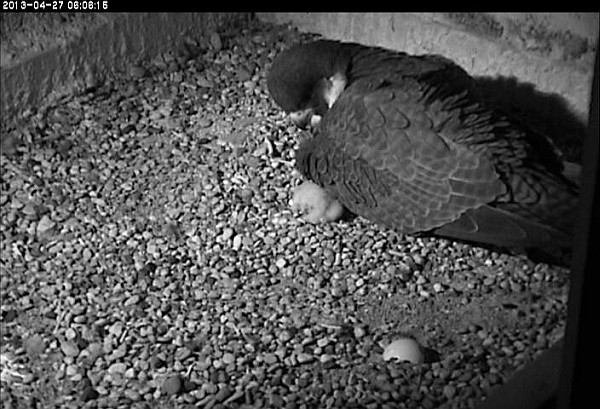
Midday Saturday he moved out of the nest scrape and did not return for feedings. Here Dorothy and E2 seem to confer about him on Saturday afternoon. (He is lying in the shade beyond them.) There was nothing to be done. He was too handicapped to survive.
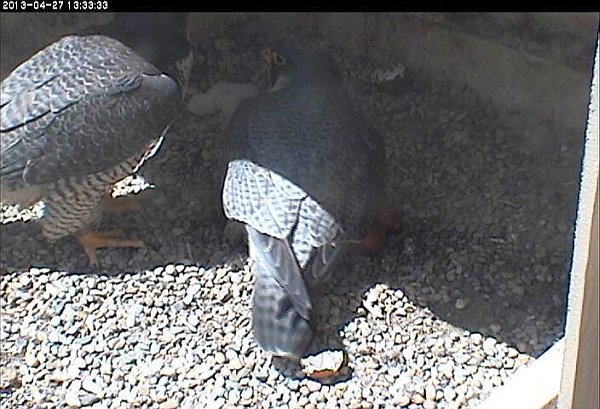
This leaves just one surviving baby out of five eggs. Until this year Dorothy always raised three to five young per nesting season — but she is 14 years old now.
Her low hatch rate and handicapped chick are both normal outcomes considering her age. Just as in humans, older mothers have fewer babies and are more likely to produce handicapped young.
I am sorry to see this happen because Dorothy is my very favorite peregrine. But the reality is that Dorothy, like all of us, is aging.
The good news is that Chick#1 is healthy and vigorous. He will get lots of attention and education from his very experienced parents.
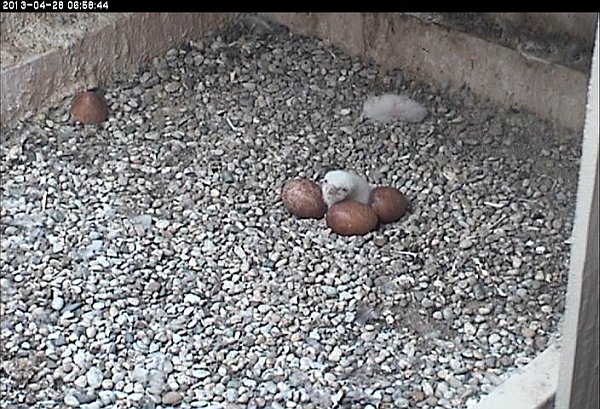
(photos from the National Aviary falconcam at the University of Pittsburgh)
Kate, this is so terribly sad. Are you saying that the remaining three eggs will not hatch, leaving Dorothy and E2 with just the one chick?
Yes, the last 3 eggs probably won’t hatch.
This is so sad….
I try to think of nature as just nature, neither kind nor cruel, and life as just a continuous opportunity for experience, good and bad. It really is the only way I can deal with it. Dorothy has served her purpose of procreation well. Can you predict what will happen when nesting time comes around again? Will it take Dorothy’s death to end her egg-laying days…will E2 seek out a new, younger mate…will another female recognize that Dorothy is declining and drive her from her territory? Or will it be another case of only time will tell?
Carol, I don’t know. Anything can happen. Dorothy’s first mate, Erie, disappeared in the fall of 2007 without any intruder trying to take his place. In 2010 at the Gulf Tower, Dori “intruded” and chased away Tasha. Only time will tell.
So very sad. The picture of Dorothy and E2 is so very touching.
What will happen with the 3 remaining eggs? Will Dorothy continue to nest over them?
Diane, Dorothy will continue to incubate the eggs until her chick doesn’t need to be brooded anymore. Then she will push the unhatched eggs aside.
Thanks, Kate, for keeping us updated, even when there is bad news in with the good. I’m sure we will all be pulling especially hard for this little one.
How sad but that is Mother Nature’s way-the weak can’t survive. I’m not sure but at 8:25 PM there is an open shell-is this the one that was up against the wall in the pictures above?
That she’ll is likely to be the same one that’s been kicking around for a while.
Since the eggs were laid over a 10-day period, why doesn’t the hatching take a similar length of time?
Peregrines eggs hatch after 33-35 days of incubation. Unlike bald eagles, peregrines wait to begin incubation until the clutch is nearly complete. That means that most of the eggs hatch within a day of each other. The last egg to hatch is delayed about 2 days because it was laid after incubation began. In this case the three remaining eggs are very unlikely to hatch.
Kate, I’m so sad about Dorothy’s chicks. Our girl is tough, she’ll hang in there.